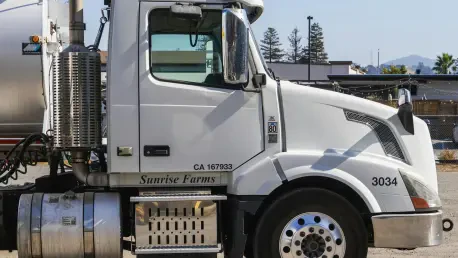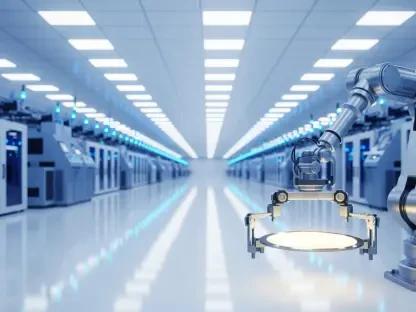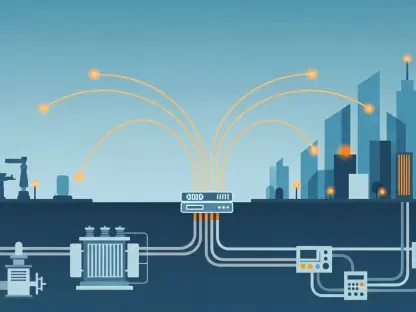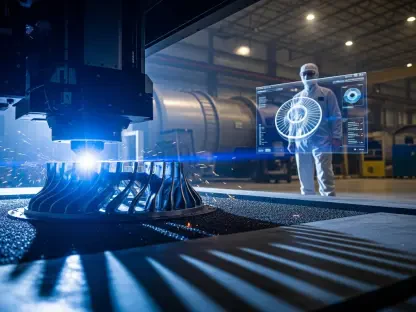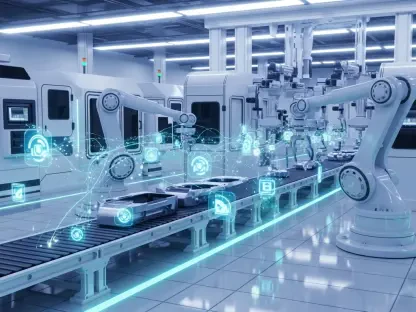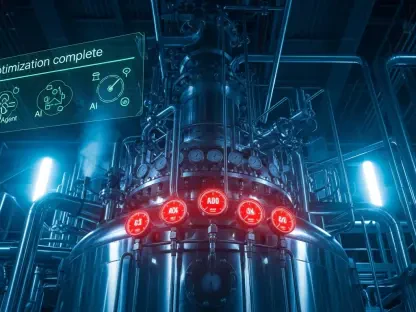Setting the Stage for a Green Revolution in Logistics
Imagine a future where the rumble of diesel trucks is replaced by the quiet hum of electric heavy commercial vehicles (eHCVs), slashing carbon emissions across India’s vast logistics network, and paving the way for a cleaner environment. This vision is becoming reality with Montra Electric, a subsidiary of the Murugappa Group under IPL Tech, unveiling a cutting-edge eHCV manufacturing plant in Manesar, Haryana. This facility isn’t just another factory; it represents a seismic shift in the commercial vehicle sector, addressing the urgent need for sustainable freight solutions amid rising environmental concerns. The plant’s launch marks a critical juncture as the industry grapples with stricter emission norms and growing demand for cleaner transport alternatives.
This market analysis aims to dissect the implications of this development for the eHCV sector in India, exploring how it aligns with broader trends toward electrification and sustainability. It examines the facility’s potential to reshape logistics, influence market dynamics, and set new benchmarks for manufacturing. By delving into current patterns and future projections, this piece offers stakeholders a roadmap to navigate the evolving landscape of commercial transportation.
The significance of this analysis lies in its timing—India stands at a crossroads where policy, technology, and market forces are converging to drive green innovation. Readers can expect a detailed breakdown of key trends, data-driven insights, and strategic recommendations to capitalize on these shifts. Let’s explore how this plant positions Montra Electric as a frontrunner in the race toward a cleaner, more efficient logistics ecosystem.
Decoding Market Trends and Projections in the eHCV Sector
Surging Demand for Electric Heavy Commercial Vehicles
The Indian commercial vehicle market is witnessing a transformative wave, with electric vehicles (EVs) gaining traction as a viable alternative to diesel-powered fleets. Heavy commercial vehicles, long a backbone of freight and logistics, have historically contributed significantly to air pollution, accounting for a substantial share of transport-related emissions. However, with government policies like subsidies and incentives under schemes such as the PM E-Drive Scheme, the adoption of eHCVs is accelerating. Market data indicates that the segment could see a compound annual growth rate of over 20% from 2025 to 2030, driven by regulatory pressures and corporate sustainability goals.
Montra Electric’s new facility in Manesar taps directly into this burgeoning demand. With an annual production capacity of 6,000 units, scalable to 7,500, the plant is poised to meet the needs of logistics firms transitioning to greener fleets. This capacity positions the company as a key supplier in a market where demand is outpacing supply, especially for heavy-duty electric vehicles tailored for long-haul and industrial applications. The strategic focus on scale and adaptability signals a readiness to address the sector’s evolving requirements.
Beyond immediate demand, the ripple effects of this development could influence fleet operators to accelerate their electrification timelines. As charging infrastructure improves and battery costs decline, barriers to adoption are diminishing, creating fertile ground for manufacturers like Montra Electric. Yet, challenges such as high upfront costs and limited range remain, underscoring the need for continued innovation and policy support to sustain this upward trajectory.
Technological Innovation as a Market Differentiator
A deeper look into the Manesar plant reveals how technology is becoming a cornerstone of competitive advantage in the eHCV market. Spanning 255,000 square feet with a built-up area of 150,000 square feet, the facility integrates 60 percent robotics and full Industry 4.0 digital manufacturing practices. Features like automated guided vehicles synced with conveyor lines enhance production efficiency, setting a new standard for precision and speed. This level of automation not only boosts output but also ensures consistent quality, a critical factor for gaining trust in a market wary of EV reliability.
The plant’s flexibility to produce multiple variants, including the Rhino EV series and future models, further strengthens its market position. Such adaptability allows Montra Electric to cater to diverse customer needs, from urban delivery to intercity freight, capturing a wider segment of the logistics industry. However, the heavy reliance on automation raises questions about cost structures and the potential displacement of manual labor, which could impact long-term operational strategies in a labor-intensive economy like India.
Market analysts predict that technological advancements will be a defining factor in the eHCV space over the next five years. Companies that leverage digital tools and modular production lines, as seen in this facility, are likely to lead in cost efficiency and product innovation. This trend suggests a shift toward smart manufacturing, where data-driven processes could redefine industry benchmarks, provided firms balance tech investments with workforce development.
Localization and Supply Chain Resilience Driving Growth
Another pivotal trend shaping the eHCV market is the emphasis on localization, evident in Montra Electric’s approach at Manesar. By sourcing 74 percent of components domestically, excluding imported cells, the company strengthens supply chain resilience amid global disruptions. This strategy aligns with national initiatives like “Make in India,” fostering a robust manufacturing ecosystem while reducing dependency on volatile international markets. The plant’s comprehensive testing facilities, including electrical labs and brake testers, further ensure that locally sourced components meet stringent quality standards.
Localization offers a dual benefit of cost reduction and faster turnaround times, giving Montra Electric a competitive edge in pricing and delivery schedules. Market projections suggest that firms prioritizing domestic sourcing could capture a larger share of government contracts and incentives, especially as policies increasingly favor local production. However, maintaining consistent component quality and managing supplier networks remain critical hurdles that could influence market penetration if not addressed.
This trend toward localization is expected to gain momentum, with more players likely to follow suit to mitigate risks from global supply chain uncertainties. For the eHCV sector, this could translate into a more stable and self-reliant market, though it requires sustained investment in local R&D and vendor ecosystems. Montra Electric’s early adoption of this approach positions it favorably to shape market dynamics in the coming years.
Sustainability and Diversity as Emerging Market Values
Sustainability isn’t just a buzzword in the eHCV market—it’s a core driver of consumer and corporate decision-making. The Manesar facility’s focus on eco-friendly production, coupled with an in-house battery pack assembly capacity of 1.7 GWh, underscores a commitment to reducing the carbon footprint of logistics. This resonates with the growing preference among fleet operators for green solutions, driven by both regulatory mandates and public pressure for cleaner transport systems. Market insights indicate that sustainability-focused brands could see a loyalty boost, particularly among large-scale logistics providers.
Equally noteworthy is the plant’s pioneering all-women fully automated battery production unit, highlighting diversity as an emerging value in industrial markets. This initiative not only addresses social impact but also positions Montra Electric as a progressive player, potentially attracting partnerships with organizations prioritizing inclusive practices. While scaling such initiatives poses challenges like training and retention, the market response to diversity-driven branding is increasingly positive, suggesting a long-term advantage.
These dual focuses on sustainability and diversity reflect broader shifts in market expectations, where ethical practices are becoming as critical as financial performance. As these values gain prominence, companies embedding them into core operations could differentiate themselves in a crowded field. For the eHCV sector, this trend points to a future where environmental and social responsibility are integral to market leadership.
Reflecting on Insights and Charting the Next Steps
Looking back, the analysis of Montra Electric’s Manesar plant launch reveals critical shifts in the eHCV market, from surging demand and technological innovation to localization and sustainability as key drivers. The facility’s integration of advanced automation, commitment to domestic sourcing, and emphasis on diversity underscore its role as a catalyst for change in India’s logistics sector. These developments highlight how strategic investments in green technology and inclusive practices reshape competitive dynamics, setting a high bar for industry peers.
Moving forward, stakeholders need to prioritize actionable strategies to leverage these trends. Businesses in logistics and transportation are encouraged to partner with innovative manufacturers to transition fleets to electric solutions, securing early-mover advantages in a rapidly evolving market. Policymakers must focus on expanding charging infrastructure and offering consistent incentives to sustain the momentum of electrification. Meanwhile, industry professionals are advised to upskill in automation and EV technologies to stay relevant amid technological disruptions.
For fleet operators and consumers, the path ahead involves advocating for and adopting eco-friendly transport options, aligning with the sustainable practices exemplified by such initiatives. The broader implication is clear: collaboration across sectors will be essential to address remaining challenges like cost barriers and infrastructure gaps. By building on these insights, the industry can drive toward a future where sustainable logistics becomes the norm, not the exception.
